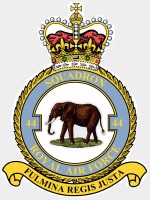Corgi AA27203 RAF Avro Vulcan B.2 Strategic Bomber - XM607, RAF No. 44 Squadron, "Operation Black Buck", Falklands Conflict, South Atlantic, 1982 (1:72 Scale)
"They have retreated, our troops have reached the outskirts of Port Stanley. A large number of Argentinian soldiers have lain down their arms. White flags are flying over Port Stanley. Our troops have been issued the command to shoot only in self-defence. Discussions among the commanders on the capitulation of the Argentinian troops in the Falklands have begun."
- British Prime Minister Margaret Thatcher, reporting on the British victory over Argentine forces, June 14th, 1982
 The Avro Vulcan, sometimes referred to as the Hawker Siddeley Vulcan, is a delta wing subsonic jet strategic bomber that was operated by the Royal Air Force (RAF) from 1953 until 1984. It was developed in response to a specification released by the Air Ministry. At the time, both jet engines and delta wings were considered cutting-edge and relatively unexplored; thus, the small-scale Avro 707 was produced to test the principles of the design. In flight, the Vulcan was an agile aircraft for its size.
The Avro Vulcan, sometimes referred to as the Hawker Siddeley Vulcan, is a delta wing subsonic jet strategic bomber that was operated by the Royal Air Force (RAF) from 1953 until 1984. It was developed in response to a specification released by the Air Ministry. At the time, both jet engines and delta wings were considered cutting-edge and relatively unexplored; thus, the small-scale Avro 707 was produced to test the principles of the design. In flight, the Vulcan was an agile aircraft for its size.
The Vulcan B.1 was first delivered to the RAF in 1956. In service, the Vulcan was armed with nuclear weapons and was a part of the RAF's V bomber force, the United Kingdom's airborne deterrent against aggression from other powers such as the Soviet Union during the Cold War. In addition to an extensive electronic countermeasures suite, the Vulcan had a small radar cross-section, aiding its deterrent role by evading detection and therefore increasing the likelihood of penetrating Soviet airspace and deploying its weapons load successfully. A second batch of aircraft, the B.2, was produced with new features, including a larger wing and greater fuel capacity, along with more advanced electronics and radar systems.
The B.2s were adapted into several other variants, the B.2A carrying the Blue Steel missile, the B.2 (MRR) for Marine Radar Reconnaissance use, and the K.2 tanker for air-to-air refuelling. The Vulcan was also used in the secondary role of conventional bombing near the end of its service life in the 1982 Falklands War against Argentina during Operation Black Buck. One example, XH558, was recently restored for use in display flights and commemoration of the employment of the aircraft in the Falklands conflict.
Pictured here is a 1:72 scale replica of a RAF Avro Vulcan B.2 strategic bomber that was attached to No. 44 Squadron, which part in "Operation Black Buck", during the Falklands Conflict in the South Atlantic in 1982.
Sold Out!
Dimensions:
Wingspan: 22-inches
Length: 22-1/2-inches
Release Date: July 2017
 Historical Account: "Operation Black Buck" - As the final RAF Avro Vulcan squadrons were contemplating their impending withdrawal from service in early 1982, developments in the South Atlantic would see this mighty bomber go to war for the first time in its 26-year service history. Operation "Black Buck" would require a Vulcan to drop 21 conventional 1,000 lb bombs on the runway at Port Stanley, in the Falkland Islands, preventing Argentine forces from using their most capable strike and support aircraft. It would also send a strong message to Argentina's political leaders that Britain would stop at nothing in re-taking the Islands.
Historical Account: "Operation Black Buck" - As the final RAF Avro Vulcan squadrons were contemplating their impending withdrawal from service in early 1982, developments in the South Atlantic would see this mighty bomber go to war for the first time in its 26-year service history. Operation "Black Buck" would require a Vulcan to drop 21 conventional 1,000 lb bombs on the runway at Port Stanley, in the Falkland Islands, preventing Argentine forces from using their most capable strike and support aircraft. It would also send a strong message to Argentina's political leaders that Britain would stop at nothing in re-taking the Islands.
The raid would be launched from RAF Ascension Island, which was some 6,300 km from the Falklands and presented something of a logistical nightmare for military planners. Flown almost entirely over the sea, the Black Buck raids would require the support of twelve Victor tankers on the outbound leg, with a further two for the return flight and all the associated contingency plans.
Taking off from Ascension Island at midnight on April 30th, 1982, Avro Vulcan B.2 XM607 piloted by Flight Lieutenant Martin Withers was to fly as reserve aircraft to the primary bomber XM598 on this highly complex raid, but was quickly promoted to lead aircraft on "Black Buck 1" following technical difficulties encountered by XM598. Embarking on what was the longest bombing raid attempt in history, XM607 was refuelled seven times on its way to the Falkland Islands, before successfully releasing its payload of bombs across the Port Stanley runway.
Following a further rendezvous with a Victor tanker on the way home, XM607 returned to its base on Ascension Island and a place in the history books - if nothing else, this raid illustrated Britain's determination to take back the Falkland Islands and that they had the capability to do it. Of the seven Black Buck raids planned against Argentine forces on the Falkland Islands, five actually took place and proved to be the only time that Britain's Mighty Avro Vulcan went to war.


